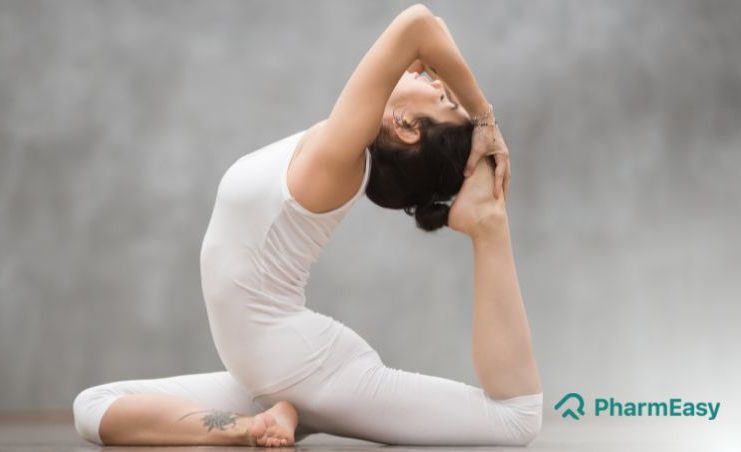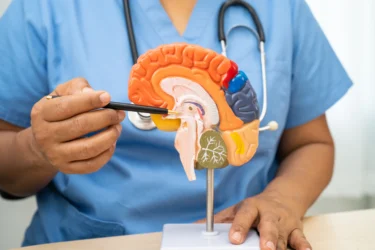Benefits of Rajakapotasana (King Pigeon Pose) and How to Do it By Dr. Himani Bisht
By Dr. Himani Bisht +2 more

Get,

to manage your symptom
Get your,


4 Cr+ families
benefitted

OTP sent to 9988776655



You’ve successfully subscribed to receive
doctor-approved tips on
Whatsapp

Get ready to feel your best.

Hi There,
Download the PharmEasy App now!!


Register to Avail the Offer
Send OTPBy continuing, you agree with our Privacy Policy and Terms and Conditions

Hi There,
Sign up on PharmEasy now!!
Trusted by 4 crore+ families

OTP sent to 9988776655



You have unlocked 25% off on medicines




Code: NU25
By Dr. Himani Bisht +2 more
Table of Contents
Isn’t it thought-provoking that yoga does not change how we see things; it transforms the person who sees? Yoga relies on your own body to strengthen it, and it uses the body to heal the body. This is what makes yoga different from other exercises. Other exercises primarily focus on external equipment and induce stress on the body. The most significant aim of yoga is to create a deep sense of unity with all living forms and compassion within1. Like other therapies, yoga alone is not the solution to any health issue, but in conjunction with different treatment approaches, yoga has the potential to offer greater well-being.
Yoga often sees the practice of asanas, one of which is Rajakapotasana or the pigeon pose. Let us look at some exciting features and benefits of Rajakapotasana.

Did You Know?
Rajakapotasana, or the pigeon pose, is one of the seated back-bending asanas (posture). It is also known as Eka pada Rajakapotasana. The term “Rajakapotasana” is derived from the Sanskrit words “Raja”, meaning king, “kapota”, meaning pigeon and “asana”, meaning seat or posture. In this pose, the chest is pushed forward like a strutting pigeon, hence the name. This asana is the second level of Kapotasana and is also known as Ek pada Rajakapotasana (one-legged king pigeon pose). In the 20th century, Krishnamacharya’s pupils described this pose for the first time2.
Rajakapotasana must be done properly for maximum health benefits. Therefore, one may perform this asana in the following manner:
It might be challenging for novices to maintain square hips in the pigeon stance. From my knowledge, if your back hip hurts, you need to correct your posture. You should feel a stretch in your front hip. In the Rajakapotasana stance, your shin should be parallel to the front of your mat. You will experience stress in your knee or ankle if your shin is not parallel. If the pressure irritates your knees, keep a soft cloth beneath your knee and thigh. It will aid with knee protection9.
Dr. Smita Barode, B.A.M.S, M.S.
The classic pigeon pose is known to provide several benefits beyond the mat, which are described as under:

Neurodegenerative disorders are characterized by progressive loss of neurons. Charlene et al. presented a case study4 in 2014, of a 61-year-old male patient with AML (adrenomyeloneuropathy), a rare type of neurodegenerative disorder; characterized by demyelization of nerve cells along the spinal cord resulting in paralysis and weakness, stiffness in lower limbs. The efficacy of a 10-month yoga intervention, including pranayamas and different asanas like Rajakapotasana, was studied in the patient. Results supported yogic postures like the pigeon pose and other pranayamas helped improve the patient’s balance, walking and intellectual intuition. However, the results of this case study should not be generalized to other individuals or disease conditions as more research is needed in this area. You should consult a doctor for proper treatment and not rely on this asana alone. Additionally, it is advised that a practitioner performs this asana under the guidance of a qualified trainer4.

Studies show that yoga helps stimulate the parasympathetic nervous system to aid the functioning of the autonomic nervous system. So-Jung Kim et al. conducted a study5 in 2022 on single mothers to verify the effectiveness of yoga intervention in managing depression. The yoga intervention consisted of five asanas, including Rajakapotasana. It is observed that people with depression have spines curled forward as they usually bend their heads. So, therefore breathing is not smooth in these individuals due to the tilt of the chest. Rajakapotasana causes the chest to expand; thus, yoga asanas like Rajakapotasana may help manage depression. However, do not rely on this asana alone if you experience major episodes of depression. It is recommended to consult a physician in such cases. Additionally, one should perform these asanas under the supervision of a qualified trainer5.

Several studies have supported the use of yoga intervention to modify cardiac risk factors like blood pressure. Parco et al. conducted a study6 in 2015, to examine the effects of one year yoga intervention on cardiovascular risk factors like blood pressure. The yoga intervention included several asanas along with Rajakapotasana Systolic blood pressure tended to improve following the yoga intervention. Thus, Rajakapotasana, when performed along with other pranayamas and asanas, may help manage high blood pressure; but should not be considered a substitute for modern medicine. Consult a doctor if you have any health issues. It is advised to practice this asana under the supervision of a qualified trainer6.

Rajakapotasana may help enhance muscular strength and flexibility. Caren Lau et al. conducted a study7 in 2015 to assess the effect of yoga intervention on muscular strength and flexibility. This yoga intervention which included Rajakapotasana had a favourable impact on muscular flexibility, strength. Even then, it can only be said it might help in improving our muscle strength. However, this asana must not be considered an alternative to modern medicine. Kindly consult a doctor if you have any muscular abnormalities. Additionally, a practitioner must perform this asana under the guidance of a qualified trainer7.
Rajakapotasana is believed to increase the range of motion in the hips. Additionally, it might make the muscles that support the lower back and hips stronger. By allowing the muscles and tendons that surround the spine to stretch, the pigeon stance may also aid with lower back discomfort. Extending the piriformis muscle may also aid with the relief of sciatica9.
Dr. Siddharth Gupta, B.A.M.S, M.D (Ayu)

Rajakapotasana may help stimulate the kidney and liver meridians through the inner groin. The lumbar arch stimulates the urinary bladder meridian, which rectifies disorders of the urinary system8. Thus, Rajakapotasana, when performed along with other pranayamas and asanas, may help in the healthy functioning of the groin area as well as the kidney, liver and bladder; but should not be considered a substitute for modern medicine. Consult a doctor if you have any health issues. It is advised to practice this asana under the supervision of a qualified trainer6.

Yoga practice may help develop the mind and body; however, it is still not an alternative to modern medicine. Therefore, you must not rely on Yoga alone to treat any condition. Instead, please consult a qualified doctor who will be able to assess your condition correctly and advise accordingly. Moreover, it is necessary to practice and learn Yoga under the supervision of a trained yoga teacher to avoid any injuries.
Conditions in which performing Rajakapotasana is contraindicated are:
Despite the many advantages of the Rajakapotasana stance, there are a few faults you should steer clear of in order to maximise your gains and lower your chance of injury. Rajakapotasana opens up the hips deeply. If you don’t warm up beforehand and your hips are stiff, you might risk being hurt. I suggest you be sure to perform light hip openers and stretches before trying the Rajakapotasana9.
Dr. Rajeev Singh, BAMS
Rajakapotasana, or the pigeon pose, is one of the seated back-bending asanas (posture). It is also known as Eka pada Rajakapotasana. The term “Rajakapotasana” is derived from the Sanskrit words “Raja”, meaning king, “kapota”, meaning pigeon and “asana”, meaning seat or posture. In this pose, the chest is pushed forward like a strutting pigeon, hence the name. This asana may help improve blood circulation and strengthen the reproductive system. In addition, it opens and stretches thighs, hips, chest, and quadriceps and improves flexibility; it stimulates the urinary bladder meridian, which rectifies urinary system disorders.
Also Read: Benefits of Sarpasana (Snake Pose) and How to Do it By Dr. Himani Bisht
Rajakapotasana is the pigeon pose. Raja means king, Kapota means pigeon and asana meaning pose. Therefore, Rajakapotasana translates to pigeon-pose in English2.
Rajakapotasana yoga pose may improve depression, neurodegenerative disorders, and blood pressure. This asana may help improve blood circulation and strengthens the reproductive system, opens and stretches thighs, hips, chest, and quadriceps and improves flexibility; it stimulates the urinary bladder meridian, which rectifies disorders of the urinary system4,8.
People having sciatica, disc disorders, and injuries of neck, shoulder, knee and pelvis should abstain from performing Rajakapotasana2.
After entering into the pigeon pose, one should try to hold the pose for about a minute2.
Pregnant women or people with knee, ankle or leg injuries and suspected sciatica should avoid this pose.
1. Shroff FM, Asgarpour M (2017) Yoga and Mental Health: A Review. Physiother Rehabil 2: 132. doi:10.4172/2573-0312.1000132. Available from: https://www.researchgate.net/publication/316946652_Yoga_and_Mental_Health_A_Review
2. B.K.S. Iyengar.Light on Yoga.The bible of Modern Yoga-Its Philosophy and practice-by the world London: Thorsons.1966;108-109. Available at: https://philpapers.org/rec/IYELOY
3. G. V. Tagare, trans., The Skanda Purana, vol. 5 (Delhi: Motilal Banarsidass, 1994), p. 83. Available at: https://www.holybooks.com/wp-content/uploads/The-Skanda-Purana-Part-1.pdf
4. Muhammad CM, Moonaz SH. Yoga as Therapy for Neurodegenerative Disorders: A Case Report of Therapeutic Yoga for Adrenomyeloneuropathy. Integr Med (Encinitas). 2014 Jun;13(3):33-9. PMID: 26770098; PMCID: PMC4684133. Available at: https://www.ncbi.nlm.nih.gov/pmc/articles/PMC4684133/#b14-33-39
5. Kim SJ, Lee YH. Effectiveness of yoga training programs to reduce depression and improve resilience of single mothers. J Exerc Rehabil. 2022 Apr 26;18(2):104-109. doi: 10.12965/jer.2244110.055. PMID: 35582689; PMCID: PMC9081409. Available at: https://www.ncbi.nlm.nih.gov/pmc/articles/PMC9081409/
6. Siu PM, Yu AP, Benzie IF, Woo J. Effects of 1-year yoga on cardiovascular risk factors in middle-aged and older adults with metabolic syndrome: a randomized trial. Diabetol Metab Syndr. 2015 Apr 30;7:40. doi: 10.1186/s13098-015-0034-3. PMID: 26000038; PMCID: PMC4440276. Available at: https://www.ncbi.nlm.nih.gov/pmc/articles/PMC4440276/
7. Lau C, Yu R, Woo J. Effects of a 12-Week Hatha Yoga Intervention on Cardiorespiratory Endurance, Muscular Strength and Endurance, and Flexibility in Hong Kong Chinese Adults: A Controlled Clinical Trial. Evid Based Complement Alternat Med. 2015;2015:958727. doi: 10.1155/2015/958727. Epub 2015 Jun 8. PMID: 26167196; PMCID: PMC4475706. Available at: https://www.ncbi.nlm.nih.gov/pmc/articles/PMC4475706/
8. Andi Céline Martin, YOGA’S EFFECT ON QUALITY OF LIFE AND PSYCHOLOGICAL DISTRESS IN KEY CAREGIVERS OF CANCER SURVIVORS. 2012. Available at: https://dalspace.library.dal.ca/bitstream/handle/10222/15398/Martin_Andi_MSc_KINE_August_2012.pdf?sequence=1&isAllowed=y
9. WebMD. How to do pigeon yoga pose. WebMD; [cited 2025 Dec 20]. Available from: https://www.webmd.com/fitness-exercise/how-to-do-pigeon-yoga-pose
Disclaimer: The information provided here is for educational/awareness purposes only and is not intended to be a substitute for medical treatment by a healthcare professional and should not be relied upon to diagnose or treat any medical condition. The reader should consult a registered medical practitioner to determine the appropriateness of the information and before consuming any medication. PharmEasy does not provide any guarantee or warranty (express or implied) regarding the accuracy, adequacy, completeness, legality, reliability or usefulness of the information; and disclaims any liability arising thereof.
Links and product recommendations in the information provided here are advertisements of third-party products available on the website. PharmEasy does not make any representation on the accuracy or suitability of such products/services. Advertisements do not influence the editorial decisions or content. The information in this blog is subject to change without notice. The authors and administrators reserve the right to modify, add, or remove content without notification. It is your responsibility to review this disclaimer regularly for any changes.
Comments

Leave your comment...
You may also like
Comments